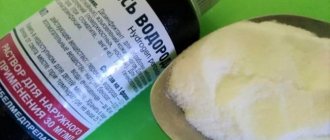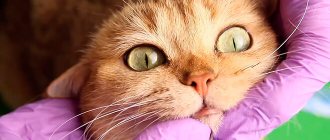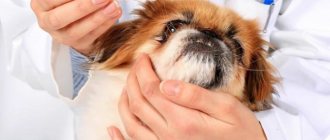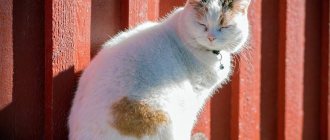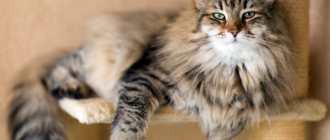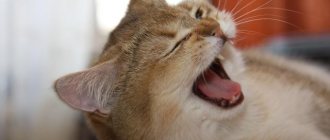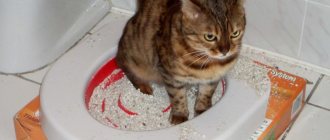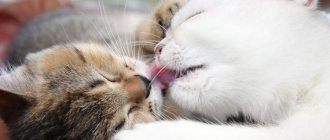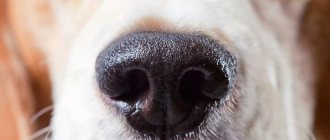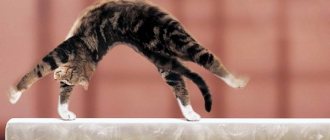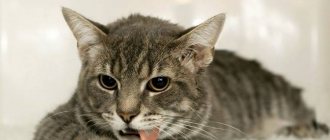When a cat with a fighting spirit lives in the house and periodically walks outside, the problem of injuring the animal arises very often. At such moments, owners unknowingly take first aid supplies from their own first aid kit and try to treat the cat’s wound, which is fundamentally wrong.
Let's find out which drugs (veterinary and medical) are allowed to be used for the treatment and treatment of cat wounds.
Treatment of superficial wounds in cats
Most often in everyday life, cats, for one reason or another, receive shallow skin wounds, which their owners can easily handle on their own at home. First of all, an animal that has been injured should be calmed down by being picked up and made to feel completely safe. Only after this is it possible to further treat the cat’s wound.
So, how can you treat a cat’s wound? This question worries many pet owners, especially if they are faced with a similar problem for the first time. Treatment of superficial skin lesions in cats should begin with high-quality washing of the wound surface with disinfectants or bactericidal agents. This is necessary to prevent the development of an inflammatory process in the wound with subsequent suppuration. For reliable disinfection, it is better to use a hydrogen peroxide solution or a chlorhexidine solution, which are usually found in any home medicine cabinet.
When deciding how to treat a cat’s wound at home, you should remember Levomekol ointment. This product for external use not only has an excellent bactericidal effect, but also has an analgesic effect, and also helps to accelerate the regenerative processes of the skin and its rapid healing. It is important to remember that before treating wounds on pets, it is necessary to remove all hair from the skin surfaces in the area of damage, and after applying disinfectants, carefully apply a gauze bandage or bandage the wound if it is on the paw.
When to go to the veterinary clinic
You should contact your veterinarian if you have the following signs:
- prolonged bleeding from the wound;
- damage where meat and torn pieces of skin are visible;
- increased body temperature in the pet, lethargy, lack of appetite;
- the appearance of vomiting and diarrhea;
- wounds with a large area;
- gunshot wounds;
- the appearance of swelling and redness in the affected area;
- pus or abscess;
- in case the pet is bitten by a tick;
- if your pet has been bitten by a snake and there is poison in the wound.
Important! If, as a result of home treatment, the wound does not improve within a few days, you should consult a doctor.
How to treat deep wounds in a cat?
Deep and open wounds in cats should be treated by a veterinarian. As a rule, such a laceration in a cat occurs as a result of a fight with dogs, and therefore often requires surgical suturing in a veterinary office or clinic. Naturally, before visiting a specialist, the damaged surface should be treated with an antiseptic to avoid infection of the soft tissues. After surgical suturing of the edges of the wound, the specialist must prescribe outpatient treatment to the animal using external agents that promote the healing of damaged skin and prevent infectious agents from penetrating into its deeper layers.
Unconventional approaches
Today, veterinarians have the opportunity to expand medical care for animals using unconventional approaches. Some advice in this regard can be found in Peter Urton's book Eczema Freedom in Three Easy Steps.
The innovative techniques and recipes presented in this unique manual really work against weeping eczema. At the same time, they are simple, accessible, and help to rid the animal of illness in a short time.
If you want to learn more about weeping eczema in cats, we advise you to become a subscriber to our blog in order to receive new interesting information in a timely manner. In addition, in your comments you can share with us your thoughts on this issue.
Goodbye, see you again!
Treatment of purulent wounds
Treatment of purulent wounds in cats is a complex and labor-intensive process that pursues several goals at once: eliminating the source of inflammation, preventing the spread of infection to neighboring tissues or its entry into the blood, as well as high-quality care for your pet, which will allow it to quickly cope with the disease. It is better to entrust the entire process of treating an infected wound in an animal to an experienced veterinarian, who, before treating a purulent wound in a cat, will assess the extent of the spread of inflammation and make the only right decision regarding further tactics and the choice of treatment method.
As a rule, when wounds in cats suppurate, a specialist prescribes general injectable antibiotics to the animal. Additionally, the wound surface should be treated with an antiseptic solution several times a day, followed by applying ointments to the wound surface that draw out pus and promote healing of damaged skin surfaces. In some cases, when the infection cannot be stopped by conservative methods, the animal owner is offered surgical excision of the infected tissue or amputation of the pet’s limb damaged by the pathological process.
First aid
After discovering a wound on your pet, give him first aid. Examine the cat and assess its condition; if it does not cause concern, then you can provide first aid yourself.
First aid:
- remove hair near the wound;
- wash the wound with antiseptic drugs - furatsilin solution, hydrogen peroxide, chlorhexidine;
- try to stop the bleeding;
- the skin around the wound can be treated with brilliant green.
After providing first aid, take the animal to a veterinarian. The doctor will select the optimal treatment regimen and show you how to properly carry out the treatments.
Features of care and feeding patterns for cats with wounds
A cat that has been diagnosed with a wound should be kept at rest until all injuries are completely healed. It is not recommended to let such a pet outside, and it is also necessary to protect it as much as possible from contact with other animals. Feeding plays an important role in the rehabilitation process of a cat with a wound. It must be balanced and aimed at fighting infection:
- Foods with irritating effects should be removed from the cat’s diet: smoked meats, sausages, sweets;
- it is necessary to increase the amount of vegetables, which contain vitamins and microelements necessary to stimulate the immune system;
- Additionally, you can give a sick cat synthetic vitamin complexes prescribed by a veterinarian.
Causes
The following factors contribute to the occurrence of eczema:
- Traumatic.
- Neuropathic.
- Reflex.
- Interior.
Traumatic eczema
It occurs as a result of damage from accessories rubbing the skin, arthropod bites, frostbite, burns, and trauma from the claws of the cats themselves. The disease occurs in a weeping form and quickly stops after its cause is eliminated.
Neuropathic eczema
It is the result of stress or a congenital anomaly. This type of eczema is characterized by symmetrical bilateral skin lesions. It occurs in dry and wet form. The disease is characterized by remissions and exacerbations under the influence of stress factors.
Reflex eczema
It is a hypersensitive response to a stimulus. The reaction occurs under the influence of the following allergens:
- Arthropod saliva.
- Household items.
- Food allergens.
- Atopic dermatitis.
- Dust.
- Accessories.
Internal factors
Internal causes of eczema are associated with organ pathologies, irrational feeding, and hormonal perversions. Signs of the disease disappear when the factor that caused them is eliminated.
Diagnostics
The veterinarian will examine the cat's head and neck, paying special attention to the scabs and the areas around them. Be sure to conduct a survey of the owner, during which they find out how long ago the first symptoms appeared, in what conditions the cat lives, what he eats and what he has been sick with recently.
Based on the clinical picture, the following diagnostic examinations are carried out:
- examination of the skin under ultraviolet light;
- biopsy of samples taken from scabs;
- general blood tests;
- bacteriological examination of smears or scrapings from scabs;
- allergy tests using special test strips.
Until a diagnosis is established, it is advisable to isolate the animal or minimize contact with household members.
A little theory
The wound in this case is a violation of the integrity of the skin layer, affecting the underlying tissue . It can be superficial (essentially a serious scratch) or deep, affecting even the muscle layer and large vessels. In pets, such pathologies are most often the result of traumatic exposure. They occur during fights, attacks by other animals, after collisions with cyclists or cars, and also include surgical injuries that have to be inflicted on the animal during surgery. In short, there are many reasons. But in this case, it is much more important to us what happens to the wound in the future.
Its healing can occur in two types , first described by the luminary of Russian medicine, N.I. Pirogov. He distinguished between healing by primary and secondary intention. With primary intention, wounds heal only after surgery: their edges are smooth, regenerative processes start immediately. Considering that during any operation the rules of asepsis and antiseptics are strictly observed, and therefore the effect of pathogenic and conditionally pathogenic microflora is completely excluded. This happens in several stages:
- Granulation. To protect itself from the penetration of microflora and debris into the wound cavity, the body begins to “darn” the wound with granulation. Fibroblasts and endothelial cells participate in the process, and new blood vessels grow from the latter.
- Increasing the epidermal layer. Epithelial cells along the edges of the wound channel gradually begin to “slide” onto the upper surface of the granulation, forming a new layer of skin epidermis.
- Myofibroblasts also play an important role in the healing process. It is from these cells that muscle fibers subsequently develop. They play the role of a kind of “ties”, literally tightening the edges of the former wound channel.
In principle, wound healing by secondary intention proceeds similarly, but in this case pyogenic microflora interferes with the process: complete granulation of the wound canal will not occur until all dead tissue and microbes are removed from the wound along with pus and other secretions. And it is with this process that difficulties may arise...
Stages of development and corresponding symptoms
The pathology develops in stages and goes through 3 stages. Each of them is accompanied by a specific set of symptoms:
- Erythematous
. One area of the skin becomes swollen and red. This occurs due to the accumulation of toxins and poor circulation. The pet becomes itchy, so it begins to actively scratch and lick itself.
- Papular
. The inflamed area becomes covered with dense tubercles. Over time, a cloudy liquid appears in them.
- Vesicular
. The bubbles, called vesicles, can be seen in detail in the photo. The vesicular stage develops according to one of two scenarios: the contents can resolve or break out. In the first case, the skin becomes rough and peels, in the second, it becomes wet and partially collapses. The leaked exudate corrodes neighboring areas, increasing the size of the erosion.
In place of the erythema, dandruff appears, the hair sticks together and falls out. Without timely treatment, the fur coat can not only lose thickness, but also disappear completely.
In addition to physiological changes, it is important to note behavioral ones. Due to constant itching and pain in scratched areas, the pet becomes apathetic and loses its appetite. The body's defenses are weakened, increasing the likelihood of a secondary infection.
Varieties according to flow form
Another classification is based on the form of the course, that is, the speed of development and severity of symptoms. The most favorable prognosis is typical for the acute form.
Acute
The acute course is characterized by the sudden appearance and rapid increase of all of the listed symptoms. Kittens often suffer from this form.
Despite their weak immunity, they recover quite quickly soon after starting drug therapy. This is explained by the timely detection of the disease and the small number of pathological changes inside the body.
Subacute
The subacute form develops after 1-1.5 months as a complication of the acute form. It is difficult to treat and often becomes chronic.
Chronic
Unlike acute and subacute, the chronic form is rarely accompanied by wet ulcers. It is characterized by constant peeling and partial baldness. Chronic pathology often occurs in older cats and pets weakened by concomitant diseases.
This disease is practically incurable and can last for years, accompanied by a series of remissions and relapses. To improve the condition of a sick animal, maintenance therapy is used.
